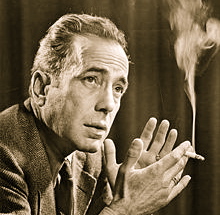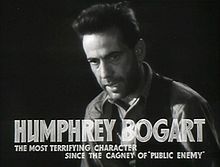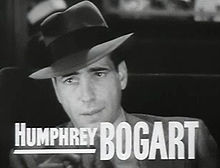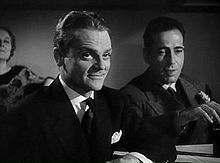Humphrey Bogart

Here’s Looking At You Kid – Casablanca

Bogart in 1946, in a photograph by Yousuf Karsh
Humphrey DeForest Bogart (December 25, 1899 – January 14, 1957) was an American actor. He is widely regarded as a cultural icon. The American Film Institute ranked Bogart as the greatest male star in the history of American cinema.
After trying various jobs, Bogart began acting in 1921 and became a regular in Broadway productions in the 1920s and 1930s. When the stock market crash of 1929reduced the demand for plays, Bogart turned to film. His first great success was as Duke Mantee in The Petrified Forest (1936), and this led to a period of typecasting as a gangster with films such as Angels with Dirty Faces (1938) and B-movies like The Return of Doctor X (1939).
Bogart’s breakthrough as a leading man came in 1941, with High Sierra and The Maltese Falcon. The next year, his performance in Casablanca raised him to the peak of his profession and, at the same time, cemented his trademark film persona, that of the hard-boiled cynic who ultimately shows his noble side. Other successes followed, including To Have and Have Not (1944); The Big Sleep (1946); Dark Passage (1947) and Key Largo (1948), with his wife Lauren Bacall; The Treasure of the Sierra Madre (1948); In a Lonely Place (1950); The African Queen (1951), for which he won his onlyAcademy Award; Sabrina (1954); and The Caine Mutiny (1954). His last movie wasThe Harder They Fall (1956). During a film career of almost thirty years, he appeared in 75 feature films.
Early career
Bogart returned home to find his father was suffering from poor health (perhaps aggravated by morphine addiction), his medical practice was faltering, and he lost much of the family’s money on bad investments in timber. During his naval days, Bogart’s character and values developed independent of family influence, and he began to rebel somewhat against their values. He came to be a liberal who hated pretensions, phonies, and snobs, and at times he defied conventional behavior and authority, traits he displayed in life and in his movies. On the other hand, he retained their traits of good manners, articulateness, punctuality, modesty, and a dislike of being touched. After his naval service, Bogart worked as a shipper and then bond salesman. He joined the Naval Reserve.
Bogart resumed his friendship with boyhood pal Bill Brady, Jr. whose father had show business connections, and eventually Bogart got an office job working for William A. Brady Sr.’s new company World Film Bogart got to try his hand at screenwriting, directing, and production, but excelled at none. For a while, he was stage manager for Brady’s daughter’s play A Ruined Lady. A few months later, in 1921, Bogart made his stage debut in Drifting as a Japanese butler in another Alice Brady play, nervously speaking one line of dialog. Several more appearances followed in her subsequent plays. Bogart liked the late hours actors kept, and enjoyed the attention an actor got on stage. He stated, “I was born to be indolent and this was the softest of rackets.” He spent a lot of his free time in speakeasies and became a heavy drinker. A barroom brawl during this time might have been the actual cause of Bogart’s lip damage, as this coincides better with the Louise Brooks account.
Bogart had been raised to believe acting was beneath a gentleman, but he enjoyed stage acting. He never took acting lessons, but was persistent and worked steadily at his craft. He appeared in at least seventeen Broadway productions between 1922 and 1935. He played juveniles or romantic second-leads in drawing room comedies. He is said to have been the first actor to ask “Tennis, anyone?” on stage. Critic Alexander Woollcott wrote of Bogart’s early work that he “is what is usually and mercifully described as inadequate.” Some reviews were kinder. Heywood Broun, reviewing Nerves wrote, “Humphrey Bogart gives the most effective performance…both dry and fresh, if that be possible.” Bogart loathed the trivial, effeminate parts he had to play early in his career, calling them “White Pants Willie” roles.
Early in his career, while playing double roles in the play Drifting at the Playhouse Theatre in 1922, Bogart met actress Helen Menken. They were married on May 20, 1926 at the Gramercy Park Hotel in New York City, divorced on November 18, 1927, but remained friends. On April 3, 1928, he married Mary Philips at her mother’s apartment in Hartford, Connecticut. She, like Menken, had a fiery temper and, like every other Bogart spouse, was an actress. He had met Mary when they appeared in the playNerves, which had a very brief run at the Comedy Theatre in September 1924.
After the stock market crash of 1929, stage production dropped off sharply, and many of the more photogenic actors headed for Hollywood. Bogart’s earliest film role is with Helen Hayes in the 1928 two-reeler The Dancing Town, of which a complete copy has never been found. He also appeared with Joan Blondell and Ruth Etting in a Vitaphone short, Broadway’s Like That (1930) which was re-discovered in 1963.
Bogart then signed a contract with Fox Film Corporation for $750 a week. Spencer Tracy was a serious Broadway actor whom Bogart liked and admired, and they became good friends and drinking buddies. It was Tracy, in 1930, who first called him “Bogey”. (Spelled variously in many sources, Bogart himself spelled his nickname “Bogie.” Tracy and Bogart appeared in their only film together in John Ford‘s early sound film Up the River (1930), with both playing inmates. It was Tracy’s film debut. Bogart then performed in The Bad Sister with Bette Davis in 1931, in a minor part.
Bogart shuttled back and forth between Hollywood and the New York stage from 1930 to 1935, suffering long periods without work. His parents had separated, and Belmont died in 1934 in debt, which Bogart eventually paid off. Bogart inherited his father’s gold ring which he always wore, even in many of his films. At his father’s deathbed, Bogart finally told Belmont how much he loved him. His second marriage was on the rocks, and he was less than happy with his acting career to date; he became depressed, irritable, and drank heavily.
The Petrified Forest
 Bogart in the 1934 original theatrical trailer
Bogart in the 1934 original theatrical trailer
Bogart starred in the Broadway play Invitation to a Murder at the Theatre Masque, now the John Golden Theatre, in 1934. The producer Arthur Hopkins heard the play from off-stage and sent for Bogart to play escaped murderer Duke Mantee in Robert E. Sherwood‘s new play, The Petrified Forest. Hopkins recalled:
When I saw the actor I was somewhat taken aback, for he was the one I never much admired. He was an antiquated juvenile who spent most of his stage life in white pants swinging a tennis racquet. He seemed as far from a cold-blooded killer as one could get, but the voice (dry and tired) persisted, and the voice was Mantee’s.
The play had 197 performances at the Broadhurst Theatre in New York in 1935. Leslie Howard though, was the star. New York Times critic Brooks Atkinson said of the play, “a peach… a roaring Western melodrama… Humphrey Bogart does the best work of his career as an actor.” Bogart said the play “marked my deliverance from the ranks of the sleek, sybaritic, stiff-shirted, swallow-tailed ‘smoothies’ to which I seemed condemned to life.” However, he was still feeling insecure.
Warner Bros. bought the screen rights to The Petrified Forest. The studio was famous for its socially-realistic, urban, low-budget action pictures; the play seemed like the perfect property for it, especially since the public was entranced by real-life criminals like John Dillinger (whom Bogart resembled) and Dutch Schultz. Bette Davis and Leslie Howard were cast. Howard, who held production rights, made it clear he wanted Bogart to star with him. The studio tested several Hollywood veterans for the Duke Mantee role, and chose Edward G. Robinson, who had first-rank star appeal and was due to make a film to fulfill his expensive contract. Bogart cabled news of this to Howard, who was in Scotland. Howard’s cabled reply was, “Att: Jack Warner Insist Bogart Play Mantee No Bogart No Deal L.H.”. When Warner Bros. saw that Howard would not budge, they gave in and cast Bogart. Jack Warner, famous for butting heads with his stars, tried to get Bogart to adopt a stage name, but Bogart stubbornly refused. Bogart never forgot Howard’s favor, and in 1952 he named his only daughter “Leslie Howard” after Howard, who had died in World War II under mysterious circumstances. Robert E. Sherwood remained a close friend of Bogart’s.
Early film career
 Invisible Stripes trailer
Invisible Stripes trailer
The film version of The Petrified Forest was released in 1936. His performance was called “brilliant”, “compelling”, and “superb.” Despite his success in an “A movie,” Bogart received a tepid twenty-six week contract at $550 per week and was typecast as a gangster in a series of “B movie” crime dramas. Bogart was proud of his success, but the fact that it came from playing a gangster weighed on him. He once said: “I can’t get in a mild discussion without turning it into an argument. There must be something in my tone of voice, or this arrogant face—something that antagonizes everybody. Nobody likes me on sight. I suppose that’s why I’m cast as the heavy.” Bogart’s roles were not only repetitive, but physically demanding and draining (studios were not yet air-conditioned), and his regimented, tightly-scheduled job at Warners was not exactly the “peachy” actor’s life he hoped for. However, he was always professional and generally respected by other actors. In those “B movie” years, Bogart started developing his lasting film persona – the wounded, stoical, cynical, charming, vulnerable, self-mocking loner with a core of honor.
The studio system, then at its most entrenched, usually restricted actors to one studio, with occasional loan-outs, and Warner Bros. had no interest in making Bogart a top star. Shooting on a new movie might begin days or only hours after shooting on the previous one was completed. Any actor who refused a role could be suspended without pay. Bogart disliked the roles chosen for him, but he worked steadily: between 1936 and 1940, Bogart averaged a movie every two months, sometimes even working on two simultaneously, as movies were not generally shot sequentially. Amenities at Warners were few compared to those for their fellow actors at MGM. Bogart thought that the Warners wardrobe department was cheap, and often wore his own suits in his movies. In High Sierra, Bogart used his own pet dog Zero to play his character’s dog, Pard. Bogart’s disputes with Warner Bros. over roles and money were similar to those the studio had with other less-than-obedient stars, such as Bette Davis, James Cagney, Errol Flynn, and Olivia de Havilland.
 Taking a back seat to James Cagney in The Roaring Twenties (1939)
Taking a back seat to James Cagney in The Roaring Twenties (1939)
The leading men ahead of Bogart at Warner Bros. included not only such classic stars as James Cagney and Edward G. Robinson, but also actors far less well-known today, such as Victor McLaglen, George Raft and Paul Muni. Most of the studio’s better movie scripts went to these men, and Bogart had to take what was left. He made films likeRacket Busters, San Quentin, and You Can’t Get Away with Murder. The only substantial leading role he got during this period was in Dead End (1937), while loaned to Samuel Goldwyn, where he portrayed a gangster modeled after Baby Face Nelson. He did play a variety of interesting supporting roles, such as in Angels with Dirty Faces (1938) (in which his character got shot by James Cagney‘s). Bogart was gunned down on film repeatedly by Cagney and Edward G. Robinson, among others. In Black Legion(1937), for a change, he played a good man caught up and destroyed by a racist organization, a movie Graham Greene called “intelligent and exciting, if rather earnest.”
In 1938, Warner Bros. put Bogart in a “hillbilly musical” called Swing Your Lady as a wrestling promoter; he later apparently considered this his worst film performance. In 1939, Bogart played a mad scientist in The Return of Doctor X. He cracked, “If it’d been Jack Warner‘s blood…I wouldn’t have minded so much. The trouble was they were drinking mine and I was making this stinking movie.” Mary Philips, in her own stage hit A Touch of Brimstone (1935), refused to give up her Broadway career to go to Hollywood with Bogart. After the play closed, however, she went to Hollywood, but insisted on continuing her career and they divorced in 1937.


